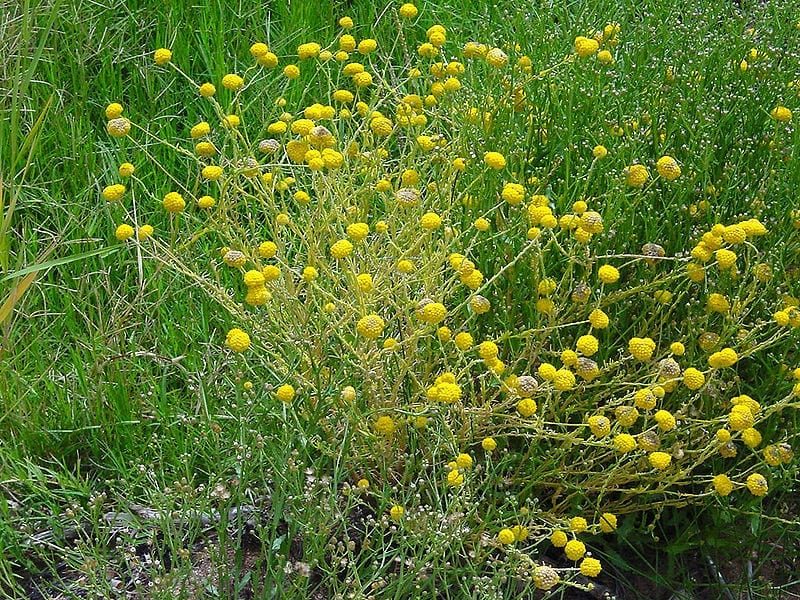
Calocephalus platycephalus
Plants of the genus Calocephalus They are so curious that they may surprise you: there are some that are herbs and others that are shrubs, with a leaf color that can be greenish or almost whitish silver depending on the species.
In addition, they are very easy to care for, since they can be grown both in the garden and in pots. Do you want to know them?
Origin and characteristics

Our protagonists are endemic plants of Australia that belong to the botanical genus Calocephalus, which is formed by these species:
- Calocephalus aervoides: grass up to 15cm tall.
- Calocephalus citreus: 0,3m tall shrub.
- Calocephalus francisii: grass up to 10cm tall.
- Calocephalus knappii: grass up to 20cm tall.
- Calocephalus lacteus: perennial herb up to 70cm tall.
- Calocephalus multiflorus: grass up to 30cm tall.
- Calocephalus platycephalus: grass up to 35cm tall.
- Calocephalus sonderi: Annual herb up to 50cm tall.
Some species that were previously in the genus have been transferred to Benosperra, Gilruthia, Gnephosis, Leucophya or Rhodanthe. This is what happened, for example, with the plant that was previously known as Cephalotus brownii, which is now called Leucophyta brownii.
As we said, They are herbaceous or shrubby plants, which can reach a height from 10cm to one meter. The flowers are small, yellow, and appear in summer.
What are their cares?

If you want to have a copy, we recommend you take care of it as follows:
Location
It is important that you place it abroad, in an area where it is in direct sunlight. Anyway, you should know that it also tolerates partial shade as long as it is exposed to the sun's rays for a minimum of 4 hours a day.
Earth
As it can be had both in a pot and in the garden, the soil must be:
- Flower pot: universal culture substrate mixed with perlite in equal parts. You can get the first here and the second here.
- Garden: it must have very good drainage, since it does not tolerate waterlogging. In the case that you have a very compact soil, make a planting hole of about 50cm x 50cm and mix it with perlite in equal parts.
Irrigation
It resists drought well, but its roots rot easily with excess water. So The ideal is to check the humidity of the soil before watering, and for this you can do any of these things:
- Use a digital moisture meter: when you enter it, it will tell you at once what degree of humidity that portion of earth that has come into contact with it has.
- Dig a bit in the earth: about 5-10cm will suffice. If you see that this soil is darker than the soil surface, do not water.
- Weigh the pot once it has been watered and again after a few days: if you notice that it weighs very little or almost nothing, water as the soil will be dry.
When in doubt, wait a couple more days to water. But anyway you should know that it is advisable to water about twice a week in summer, and a little less the rest of the year.
Pruning
It's not necesary. It will be enough to remove the dry, diseased or weak leaves, as well as the withered flowers.
Multiplication
It multiplies by seeds in spring, following this step by step:
- The first thing to do is fill the seedbed (pot or seedling tray) with universal growing medium mixed with 30% perlite.
- Then, it is watered conscientiously, ensuring that the soil is well soaked.
- Afterwards, the seeds are placed on the surface of the substrate, leaving a distance between them of 2-3cm.
- Finally, they are covered with a thin layer of substrate and irrigated again with a sprayer to then place the seedbed outside, in full sun.
Plagues and diseases
It's very tough. Even so, if the growing conditions are not adequate, it should not be ruled out that it may be affected by mealybugs, aphids or fungus if the humidity is excessive. The first two are treated with specific insecticides, anti-mealybugs and anti-aphids, and for the latter, fungicides must be used. In any case, the indications specified on the product packaging must be followed.
Rusticity
It resists well cold and weak frosts of up to -2ºC. If you live in a colder area, it should be kept indoors, in a well-lit room without drafts until spring returns.
What uses does it have?

Calocephalus lacteus
Species of the genus Calocephalus are used as ornamental plants in low maintenance gardens, since they withstand periods of little water well. Either as isolated specimens or in groups, in rockeries or in hanging pots, they are a great option for everyone.
These plants are very interesting to grow in areas where it rains rather little, such as in the Mediterranean region. But what about you?
